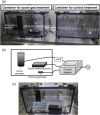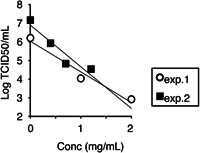Reduction of severe acute respiratory syndrome coronavirus-2 infectivity by admissible concentration of ozone gas and water
- PMID: 33230863
- PMCID: PMC7753712
- DOI: 10.1111/1348-0421.12861
Reduction of severe acute respiratory syndrome coronavirus-2 infectivity by admissible concentration of ozone gas and water
Abstract
Severe acute respiratory syndrome coronavirus 2 (SARS-CoV-2) is causing the global coronavirus disease 2019 (COVID-19) pandemic. Because complete elimination of SARS-CoV-2 appears difficult, decreasing the risk of transmission is important. Treatment with 0.1 and 0.05 ppm ozone gas for 10 and 20 hr, respectively, decreased SARS-CoV-2 infectivity by about 95%. The magnitude of the effect was dependent on humidity. Treatment with 1 and 2 mg/L ozone water for 10 s reduced SARS-CoV-2 infectivity by about 2 and 3 logs, respectively. Our results suggest that low-dose ozone, in the form of gas and water, is effective against SARS-CoV-2.
Keywords: SARS-CoV-2; TCID50; humidity; ozone gas; ozone water.
© 2020 The Societies and John Wiley & Sons Australia, Ltd.
Figures



Similar articles
-
Inactivation Effects of Hypochlorous Acid, Chlorine Dioxide, and Ozone on Airborne SARS-CoV-2 and Influenza A Virus.Food Environ Virol. 2025 Jan 3;17(1):9. doi: 10.1007/s12560-024-09626-y. Food Environ Virol. 2025. PMID: 39752095 Free PMC article.
-
In vitro inactivation of SARS-CoV-2 by ozonated water via novel hand hygiene device.J Appl Microbiol. 2023 Jul 4;134(7):lxad147. doi: 10.1093/jambio/lxad147. J Appl Microbiol. 2023. PMID: 37451808
-
An automated room disinfection system using ozone is highly active against surrogates for SARS-CoV-2.J Hosp Infect. 2021 Jun;112:108-113. doi: 10.1016/j.jhin.2021.04.007. Epub 2021 Apr 15. J Hosp Infect. 2021. PMID: 33864891 Free PMC article.
-
The role of ozone therapy in severe acute respiratory syndrome coronavirus 2 (SARS-CoV-2) infection and coronavirus disease 2019 (COVID-19): a review.Med Gas Res. 2023 Oct-Dec;13(4):165-171. doi: 10.4103/2045-9912.369237. Med Gas Res. 2023. PMID: 37077113 Free PMC article. Review.
-
Perspective of the Relationship between the Susceptibility to Initial SARS-CoV-2 Infectivity and Optimal Nasal Conditioning of Inhaled Air.Int J Mol Sci. 2021 Jul 24;22(15):7919. doi: 10.3390/ijms22157919. Int J Mol Sci. 2021. PMID: 34360686 Free PMC article. Review.
Cited by
-
Mechanisms of Plasma Ozone and UV-C Sterilization of SARS-CoV-2 Explored through Atomic Force Microscopy.ACS Appl Mater Interfaces. 2024 Sep 18;16(37):49176-49185. doi: 10.1021/acsami.4c11057. Epub 2024 Sep 6. ACS Appl Mater Interfaces. 2024. PMID: 39240691 Free PMC article.
-
Resource Recovery Strategy of Rapid Screening Kits for Diseases through Ozonation.Environ Health (Wash). 2023 Sep 11;1(5):324-331. doi: 10.1021/envhealth.3c00109. eCollection 2023 Nov 17. Environ Health (Wash). 2023. PMID: 39474279 Free PMC article.
-
Laboratory studies on the infectivity of human respiratory viruses: Experimental conditions, detections, and resistance to the atmospheric environment.Fundam Res. 2024 Feb 21;4(3):471-483. doi: 10.1016/j.fmre.2023.12.017. eCollection 2024 May. Fundam Res. 2024. PMID: 38933192 Free PMC article. Review.
-
Ozone Treatment Is Insufficient to Inactivate SARS-CoV-2 Surrogate under Field Conditions.Antioxidants (Basel). 2021 Sep 16;10(9):1480. doi: 10.3390/antiox10091480. Antioxidants (Basel). 2021. PMID: 34573110 Free PMC article.
-
Inactivation Effects of Hypochlorous Acid, Chlorine Dioxide, and Ozone on Airborne SARS-CoV-2 and Influenza A Virus.Food Environ Virol. 2025 Jan 3;17(1):9. doi: 10.1007/s12560-024-09626-y. Food Environ Virol. 2025. PMID: 39752095 Free PMC article.
References
-
- World Health Organization . COVID‐19 situation reports. Geneva: World Health Organization; 2020.
MeSH terms
Substances
Grants and funding
LinkOut - more resources
Full Text Sources
Medical
Miscellaneous

